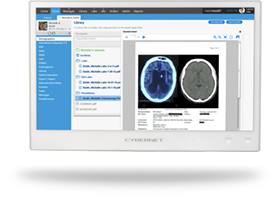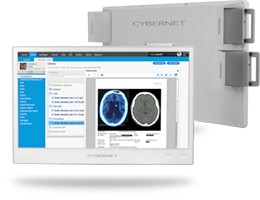Implementing new technology in healthcare has always been the key to better treatment and results. We created bandages to stop bleeding and protect open wounds, developed sterilization protocols to prevent infections, and invented X-ray machines to see our bones beneath layers of skin and muscles.
Embracing technological innovation is crucial to delivering a better healthcare experience, whether that means opening up new treatment options or making existing methods faster and more efficient. However, the challenges of using new techniques and equipment mean you need to have a strong plan and reliable partners to count on.
Benefits of Implementing New Technology in Healthcare
Before getting into the challenges and best practices for implementing new technology in healthcare, it’s helpful to review the benefits of doing so. This will provide you with context going forward for why we invest so much effort in introducing new tools and methods in the first place.
Better Results for Patients
First and foremost, new resources and technology help deliver better results for patients. Multiple new technology trends, including generative AI, drug discovery, and robotics, are converging in the healthcare sector. With these tools, we can have faster, more accurate diagnoses of a patient’s condition, more effective medicine with fewer side effects, and precise surgical equipment that leads to quicker recovery times.
Increased Accessibility
One of the greatest limiting factors for healthcare is that the patient and the provider must be in the same physical location. This can be difficult or even impossible in certain circumstances, such as when the patient resides in a remote, rural area or when a specialist consultation is required. New technologies, such as telehealth and video calls, help bridge this physical divide and ensure that patients can get the care they need, no matter where they live.
Easier Information Sharing
Another major issue that healthcare has historically struggled with is the sharing of information. Historically, a patient’s medical records were recorded on paper, which made them difficult to share, vulnerable to damage and destruction, and a hassle to store. Digital solutions, such as electronic health records (EHRs) and cloud computing, enable providers to share critical information instantly across vast distances, without fear of physical copies being misplaced or destroyed.
Workflow Efficiency
Implementing new technology in healthcare also makes the industry’s everyday work processes faster and more efficient. EHRs are updated automatically for all authorized users, sparing employees from having to update via phone call or email. Automated messages, such as appointment reminders and test results, keep patients up to date on their treatment without requiring direct attention from employees as well. These innovations may not be as groundbreaking as the invention of penicillin or the MRI machine, but they make a difference for healthcare providers in countless small ways every single day.
Common Issues With Implementing New Technology in Healthcare
Despite the obvious benefits that come with the implementation of new technology in healthcare, there will always be hesitation and resistance in the face of any change. Typical issues with implementing new technology in healthcare are:
Upfront Costs
Obviously, everything has a price tag, and medical equipment is no different. New technology can be costly to purchase and integrate into a hospital’s operations, due to the initial price and any loss in efficiency while employees get used to the new tools. This can be doubly true if it requires replacing other related devices due to a lack of compatibility.
Hospitals must carefully examine their budget to determine if new technology can save money in the long term and explore cost-saving measures, such as legacy compatibility. An all-in-one medical PC with legacy I/O ports can function with both modern and legacy devices, sparing you the need to replace your entire fleet of equipment.
Training and Deployment
One of the most common issues for any active healthcare facility is balancing the need for training and supplementary education with the day-to-day requirements of their work. A factory can temporarily shut down operations to upgrade its machinery and train its workers on its use, accepting the short-term loss in profits for the sake of future efficiency. A hospital cannot tell patients with potentially life-threatening conditions, “Sorry, you’ll need to come back next week.”
This issue is best countered by developing technology to be as intuitive and user-friendly as possible to reduce training requirements. Touchscreen interfaces are a great example of this design philosophy, as they let providers simply tap on the element they wish to interact with.
Provider Reluctance
As with any group of skilled professionals, healthcare providers can be set in their ways and unwilling to change their approach or operations. “If it ain’t broke, don’t fix it” is a common statement for a reason. Sadly, this can lead to genuinely useful and effective tools going unused out of a reluctance to adapt them.
Dealing with this issue involves having a sincere dialogue with providers about their concerns and priorities. A huge concern for many workers in the healthcare sector is “pajama time,” where they have to continue filling out paperwork even outside of their work hours. Addressing this kind of problem and the burnout that it contributes to is an olive branch to providers, showing that you genuinely have their interests at heart.
Best Practices for Implementing New Technology in Healthcare
Integrating new tools or workflows into a healthcare environment is far more complex than consumer shopping. It is a process that must draw on the skills and knowledge of multiple fields and meet the requirements of several layers of regulation. These best practices are meant to serve as a guideline for how to implement new technology in healthcare.
Assess Your Needs and Plan Appropriately
First, you need to assess your current situation, the issue you want to overcome, and your options for addressing it. A common mistake is to fixate on the newest, shiniest piece of technology without considering how and where it will be integrated with your existing structures and processes. This can lead to serious issues with compatibility and regulation, where your new tech can’t communicate with other equipment you rely on or fails to meet critical healthcare regulations such as HIPAA compliance.
Key components of an effective plan for implementation include:
- Budgeting: Obviously, you need to make sure you can afford your new equipment! This category also includes additional costs outside of the sticker price, such as training, installation, consultant fees, etc.
- Staffing: If this new technology involves expanding your operations, you may also need to expand your workforce. For example, advanced imaging devices, such as CT scanners and MRI machines, require specialized personnel to operate them.
- Timelines: A new implementation project can span months, potentially years, from the initial conception to full deployment. It’s crucial to ensure that your project doesn’t overlap or interfere with other initiatives within your healthcare group.
- Scalability: Healthcare operations are constantly changing to match population shifts, demographic changes, and more. If you go from having to support one thousand patients to two thousand with your new technology, can your choice support this growth? Can the manufacturer that supplies your tools keep up with demand?
Establish a Pilot Program and Communicate with Stakeholders
Once you’ve assessed your needs and made an initial selection, a pilot program is an excellent way to see how it works in the real world. For example, rather than replacing an entire fleet of computers with new models, test out just one or two and see if they bring the improvements you’re looking for. Doing so will also let you identify any pain points and have them corrected before large-scale deployment.
During this process, stay engaged with the various stakeholders involved, including providers, IT staff, and even patients themselves. They will be the first to tell you if something is wrong with your new technology and offer potential solutions.
Train Your Staff and Listen to Feedback
Don’t expect employees to immediately grasp a new tool right away, especially in a field as complicated and nuanced as healthcare. It’s absolutely critical, for both your operations and your patients, that they have access to training material and trusted consultants to help them adapt to this new technology.
If your employees come to you with concerns or warnings during this process, take them seriously and investigate. These concerns are often the sign of one of two things: either your training methods have a serious oversight, or there is a genuine issue with how your new tools are designed or used. Both of these issues require immediate correction.
Evaluate, Assess, and Adjust as Needed
After implementing your new technology, monitor its impact on your operations. If your new equipment or processes aren’t making the impact you were hoping for, consider discussing with your staff and partners to determine the reasons. This can help you adjust your plans or deployment as necessary.
You may also need to make updates to one tool based on changes in other equipment or workflows. For example, if your healthcare group starts using RFID bracelets to track patients or consumables, you will want to have a medical computer tablet capable of scanning RFID tags to go along with it.
Upgrade Your Operations With Cybernet Manufacturing
As the healthcare sector continues to evolve, companies within the sector must evolve with it. This means embracing and implementing new technologies in healthcare as they reach the market.
If you’re looking to upgrade your healthcare group’s operations with new medical-grade computers, contact Cybernet Manufacturing. Our experience as an original equipment manufacturer enables us to assist you throughout the implementation process and even customize our products to meet your specific requirements.

